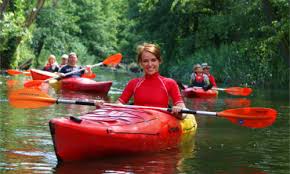FORMS OF CULTIVATING KAYAK TOURISM

So that rest in the bosom of nature fulfills its task, we have to prepare the trip properly. The massive development of canoeing tourism in recent years has created multiple types of trips for a large number of lovers of this beautiful branch of tourism., parties, Sunday kayaking trips. We organize events from one-day through several and several-day-long to almost monthly foreign events.
A rich calendar of kayaking events allows you to choose the appropriate route depending on the level of advancement or interest of the participant or participants. Each PTTK unit provides information and advice on the selection or organization of a trip. The above-mentioned calendar allows us to get to know the most beautiful rivers, lakes of our country and makes it possible to get to know the water routes of our neighbors.
Here are the most important of the boating events: a central event organized every year in a different attractive corner of Poland, nationwide events, international (Hills, masuria, Dunajec), district, departmental and club. All of them enable relaxation, getting to know nature, monuments, etc.. In addition, workplaces (Company Circles of PTTK and Zw. Zaw.) they organize rafting and excursions at the most appropriate time (June, July, August). Saturday-Sunday kayaking trips with camping became widespread. These kayaking trips, having an outstandingly recreational character, they must be organized like this, that the participants come back fully satisfied and refreshed. In the absence of a kayaking leader, the tour manager should be an experienced boater, knowing the trail. It is known, however, that organizing any event is a responsible and quite complicated task. To avoid improvisation, as well as exposing participants to danger or unnecessary fatigue, we should ask for help from the PTTK unit, to organize a trip or delegate a canoeing tourism leader. Then we outline the plan of the entire trip, which should look like this:
a) route selection - a sketch to announce to participants (enter kilometers)
b) transport of participants and equipment to the start or end point
c) day schedule
d) accommodation (tents, riverside hostels, at the hosts)
e) cost of the trip
f) equipment
We take a lot more work to organize a multi-day trip. Here you should spread the work like this, so that the preparations run smoothly and smoothly.
The above-mentioned must make the following preparations:
a) propagate the tour through messages, announcements, the press
b) develop the route of the trip - taking into account the daily stages, which depend on the fitness of the participants and the nature of the waters (the river, Lakes, rivers, channels). One should remember, that the daily stage on lowland rivers should not exceed 26-30 km, on lakes - canals 16-20 km, on rivers or rivers with portages (one or two a day) — 24 km, on mountain rivers - 40 km.
c) provide floating and camping equipment and its transport
d) provide lifeguard care (cows) and sanitary
e) prepare food for participants on the route
f) provide a camping place
g) obtain a permit to travel along rivers and lakes constituting reserves or areas of closed waters
h) make plans for the day including sightseeing, reserves
i) arrange regulations for participants j) prepare a cost estimate for the trip
k) provide insurance for participants
l) prepare information about the exact journey to the take-off site
Ł) appoint group leaders depending on the recruitment of participants
m) check the validity of swimming cards.
It will be the responsibility of section managers to familiarize participants with the route, mileage, the program of the day, ensuring the punctuality and safety of the group, inspection of the floating equipment and checking its readiness for rafting.
The above-mentioned rafting preparations for larger groups of participants are almost the same for groups consisting of two or three kayaks. A well-coordinated company should also remember about the basic principles of preparing a trip. Group leader, selected from among the participants, should take care of the preparation of the route, after reading the description in the guide, with the PKP and PKS timetables, the possibility of transporting canoes, calculating the cost of the trip and exploring the possibility of camping, provisioning and staying in the selected area. A thoroughly prepared event will give us satisfaction, nice memories, rest, it will allow you to get to know the beautiful water routes.
After reporting tourists, when they are located and checked for presence, camping and floating equipment should be separated (if provided by the organizer). The first day is spent on the preparation of the equipment and organizational matters before the kayaking trip. Management convenes the individual group managers' briefings, presents the regulations once again, then discusses the schedule for the first day of the trip, with the exact route, mileage, stopping places to rest, more important places or objects on the route, the end of the stage and the arrangement of individual groups during the trip. After discussing the above-mentioned guidelines, group leaders should provide their participants with the data received from the event organizers, and, if possible, provide an exact sketch of the route. The daily schedule should be more or less as follows:
1. incentive, morning gymnastics hours. 6.00—6.20
2. washing, dressing up, preparation of breakfast 6.20-7.00
3. breakfast 7.00-7.30
4. cleaning, folding camping equipment
5. preparation of floating equipment 7.30-8.00
and its loading 8.00-8.45
5. checking readiness 8.45-9.00
7. rafting 9.00-12.00
8. break, preparation of lunch and lunch 12.00-14.00
9. cleaning up after lunch and rest 14.00-14.45
10. visiting 14.45—16.00
11. the continuation of the trip 16.00-18.00
12. end of stage, inspection of the equipment 18.00-18.30
13. breaking the camp 6.30-19.00
14. dinner and its preparation 19.00-20.00
15. cleaning up after dinner and preparing accommodation 20.00-21.00
16. bonfire 21.00-22.00
17. night silence 22.00—6.00